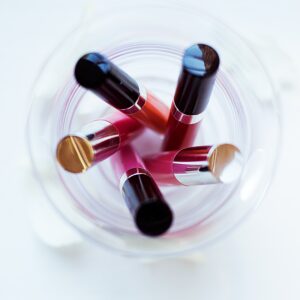Harmful Ingredients to Avoid and Why Choosing Natural Ingredients in Lipsticks

Lipstick has been a beloved cosmetic item for centuries, with various formulations and shades to cater to every person’s taste. While lipstick can enhance our beauty and confidence, some of the ingredients used in traditional lipsticks can be harmful to our health. In this blog, we will discuss some of the harmful ingredients to avoid in lipsticks and why choosing natural products is the way to go.
Harmful Ingredients
Parabens
They are synthetic preservatives commonly used in cosmetics, including lipsticks, to extend their shelf life. Parabens can mimic estrogen in the body, leading to hormonal imbalances and potential health risks.
The use of parabens in cosmetics has been linked to an increased risk of breast cancer, although the exact relationship remains unclear. Therefore, it is best to avoid lipsticks that contain parabens and opt for natural alternatives instead.
Lead
It is a toxic heavy metal that can be found in some traditional lipsticks. Lead is not an ingredient in lipsticks, but it can be present as a contaminant in the manufacturing process. Long-term exposure to lead can lead to serious health problems, such as neurological damage, developmental delays, and anemia.
Therefore, it is crucial to choose lead-free lipsticks or products that have been tested for lead content.
Phthalates
Phthalates are a group of chemicals used in cosmetics to improve their texture and flexibility. It has been linked to hormonal disruptions, reproductive problems, and birth defects in animal studies.
Although the exact effects of phthalates on human health are still unclear, it is best to avoid them in lipsticks and other cosmetic products. Look for phthalate-free lipsticks that use natural ingredients such as beeswax or plant oils to improve their texture.
Synthetic Fragrances
Synthetic fragrances are a common ingredient in many lipsticks and other cosmetic products. These fragrances are often made from synthetic chemicals that can cause skin irritation and allergic reactions.
Synthetic fragrances are also known to contain phthalates, which can be harmful to our health. It is best to choose natural fragrances from essential oils or plant extracts to avoid potential health risks.
Petroleum-Based Ingredients
Petroleum-based ingredients, such as mineral oil, petrolatum, and paraffin wax, are commonly used in traditional lipsticks to improve their texture and longevity. These ingredients can clog pores and prevent the skin from breathing, leading to dryness and irritation.
Petroleum-based ingredients can also be contaminated with harmful impurities, such as polycyclic aromatic hydrocarbons (PAHs), which are known carcinogens. It is best to choose natural ingredients, such as plant oils and waxes, to avoid potential health risks.
Natural Ingredients
Natural ingredients are a safer and healthier alternative to traditional lipstick ingredients. They are derived from plants, minerals, and other natural sources and do not contain harmful chemicals or contaminants. Some common natural ingredients used in lipsticks include beeswax, jojoba oil, shea butter, and cocoa butter.
Beeswax is a natural emollient that moisturizes and protects the lips, while jojoba oil is a lightweight oil that is easily absorbed into the skin, leaving it soft and supple.
Shea butter and cocoa butter are rich in antioxidants and fatty acids, which help to nourish and repair the skin.
Natural ingredients also provide a range of benefits for the environment, such as reducing the use of chemicals and promoting sustainable farming practices.
Choosing Natural Lipsticks
Choosing natural lipsticks can be a daunting task, given the number of options available in the market. 100% PURE is our favorite brand for makeup and skincare. Here are some tips to help you choose the best natural lipsticks for your needs:
- Read the label: Look for lipsticks that contain natural ingredients and avoid those that contain harmful chemicals such as parabens, lead, phthalates, synthetic fragrances, and petroleum-based ingredients. Make sure to read the full list of ingredients, as some products may claim to be natural but still contain harmful substances.
- Look for certifications: Look for products that have been certified by reputable organizations such as the USDA or the Natural Products Association. These certifications ensure that the product has met certain standards for natural and organic ingredients.
- Try samples: Before purchasing a full-sized product, try samples to test the color and texture of the lipstick. Some natural lipsticks may have a different texture or wear time than traditional lipsticks, so it’s important to test them out first.
- Check reviews: Look for reviews from other customers to see their experiences with the product. This can give you a better idea of the product’s performance and quality.
- Support ethical brands: Look for brands that are committed to using sustainable and ethical practices. This includes using environmentally-friendly packaging and sourcing ingredients from fair trade and organic sources.
Benefits of Natural Lipsticks
Choosing natural lipsticks not only benefits our health but also has a positive impact on the environment and society. Here are some of the benefits of using natural lipsticks:
-
- Healthier ingredients: Natural lipsticks contain ingredients that are derived from plants and minerals, which are safer and healthier for our bodies than synthetic chemicals.
- Reduced environmental impact: Natural lipsticks use ingredients that are grown and harvested using sustainable farming practices, reducing the use of harmful chemicals and promoting biodiversity.
- Ethical sourcing: Natural lipsticks use ingredients sourced from fair trade and organic sources, ensuring that farmers and workers are paid fair wages and treated ethically.
- Cruelty-free: Natural lipsticks are often cruelty-free, meaning they are not tested on animals.


